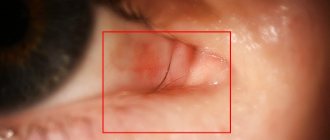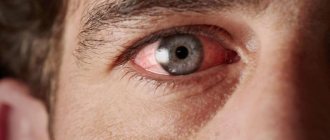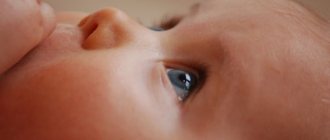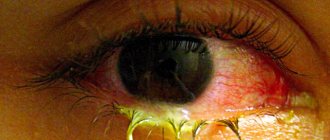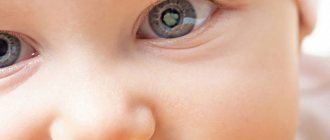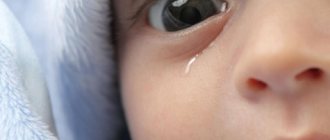Causes of the disease
Conjunctivitis in a child can occur for many reasons:
- a viral, bacterial or fungal infection that can enter the eye through dirty hands, from a sick person or other infectious diseases;
- allergies to external irritants - flower and tree pollen, animal hair, household chemicals;
- mechanical irritants - street dust, sand, garbage;
- reaction to medications;
- functional eye disorders;
- metabolic disorders, vitamin deficiency;
- chronic diseases of the organs of vision and nasopharynx.
To prescribe treatment, the doctor needs to find out the type of conjunctivitis and its cause.
How is ocular conjunctivitis transmitted in children?
Ways of transmission of conjunctivitis:
- Through dirty hands
- Airborne
- When visiting the pool
- When using general hygiene items
Children often catch the disease in kindergarten. This happens while playing or when drying off a friend with a towel. What often happens in middle and older groups.
How is ocular conjunctivitis transmitted in children?
How long does conjunctivitis last in children?
It is possible to answer the question: how long does it take to treat conjunctivitis in children and how long does it last, only after a complete diagnosis.
If the disease has a viral etiology, it can last from 5 to 20 days. It all depends on the individual characteristics of the baby, his immunity. Adenoviral conjunctivitis lasts no more than a week, is mild and goes away on its own. The herpetic form has a severe course and requires treatment.
Bacterial conjunctivitis can last for several weeks and will not go away on its own. This type of disease requires serious antibiotic therapy under the supervision of a doctor. The type of medication is determined according to the causative agent of the infection. The most difficult to tolerate are diphtheria, meningococcal and gonococcal infections, which may require treatment for 2 to 3 months.
The allergic type of conjunctivitis can last for years. In the presence of provoking facts, it will worsen; in the absence, periods of remission will occur. If no age-related changes occur in the child’s body, it can last a lifetime.
How many days is conjunctivitis contagious in children and why is it dangerous?
In fact, only bacterial disease is dangerous. It can be transmitted when babies come into contact with each other. Viral conjunctivitis is caused by adenovirus and other viral infections. In this case, the child may initially get a cold, and conjunctivitis will appear as a complication.
Bacterial conjunctivitis is dangerous until the child has fully recovered and can be transmitted. On average, the incubation period is 5-7 days. Viral conjunctivitis is transmitted by airborne droplets and initially affects the upper respiratory tract. The incubation period is 7-10 days.
How many days is conjunctivitis contagious in children and why is it dangerous?
Signs of conjunctivitis in children
In children, the symptoms of the disease are more pronounced; at the slightest discomfort, children rub their eyes with their hands and aggravate the symptoms. They react more strongly than adults to irritating factors. Mothers should not ignore the signs of conjunctivitis in their child:
- redness of the eyes;
- slight swelling of the eyelids;
- heightened reaction to bright light;
- dried purulent crusts on the eyelids;
- purulent discharge in the corners of the organs of vision and clots of pus floating along the mucous membrane;
- eyes stick together after sleep;
- the baby becomes restless and capricious.
Additionally, symptoms of ARVI or another disease may be present.
Types of conjunctivitis
The disease is divided into several types and each of them has its own symptoms and different treatment.
Allergic – inflammation of the mucous membrane of the eye in response to irritation by allergens. An allergic reaction can be caused by: flower and tree pollen, house mites, animal hair, household chemicals and medications. The child feels a burning sensation in the eyes, redness, tearing and swelling appear.
Viral - develops along with ARVI, the causative agent is a viral infection, enters with dirty hands or through the blood. Reduced immunity contributes to the development of the disease. It manifests itself as inflammation of the mucous membrane of the eyes, redness, lacrimation, and slight purulent discharge. The form of the disease is mild and can be treated within a few days.
Treatment of conjunctivitis in children
If a child develops characteristic symptoms, it is necessary to consult an ophthalmologist. The doctor will identify the cause of conjunctivitis and prescribe treatment.
If first medical attention is necessary, you can use Albucid eye drops. They are suitable for small children of any age.
If there are symptoms of allergic conjunctivitis, you can use antiallergic drops and give your baby an antihistamine. If the nature of the disease is not determined, you can wash your eyes with a solution of boric acid, furatsilin or chamomile decoction.
How to properly wash your child's eyes
You need to wash your baby's eyes with a cotton swab from the outer corner of the eye to the inner corner, taking a new one for each organ of vision. It is necessary to remove crusts from the eyelids by soaking them with the same solution. The frequency of irrigation depends on the appearance of discharge or pus.
As soon as the condition improves, rinsing is done less frequently, no more than three per day. If conjunctivitis is allergic, the eyes are not washed.
Even if one eye is affected, the second is washed with a clean swab for prevention; a child can easily infect the second organ of vision with his hands. You can apply eye ointment - tetracycline or erythromycin - behind the lower eyelid. These ointments contain an antibiotic, so they are used in children as prescribed by a doctor.
Attention! All medical procedures for the baby’s eyes should be carried out with clean hands or wearing medical gloves.
For infants, apply eye drops with a special pipette; if the drops were stored in the refrigerator, they should be warmed in your hands.
For viral conjunctivitis, the doctor prescribes antiviral drugs and eye drops. If there is a herpes infection, Zovirax or Acyclovir is additionally used. Trifluridine and Actipol antiviral drops are recommended for eye drops.
If the disease is of an allergic nature, it is necessary to identify the allergen and try to remove it from the child’s life (as far as possible). It is best to consult an allergist for testing and specific therapy. Antiallergic drops Cromohexal and antihistamines are used for the eyes.
Important! You cannot self-medicate your baby. When using any drug, consult a doctor.
The duration of treatment depends on the cause of the disease and the child’s immunity. Typically, conjunctivitis in children is treated for 10 to 14 days. With proper treatment, conjunctivitis has no complications; if it is neglected, the child’s vision may deteriorate and irreversible eye processes may begin.
What drops and ointments should be used for conjunctivitis in children?
Drops and ointments for viral conjunctivitis:
- Albucid
- Poludan
- Aktipol
- Florenal
- Zovirax
- Virolex
Drops and ointments for bacterial diseases:
- Tsiprolet
- Vatabakt
- Erythromycin ointment
- Tetracycline ointment
What drops and ointments should be used for conjunctivitis in children?
Signs of the disease
All diseases of the conjunctiva, caused by different etiologies, have a similar clinical picture. Most often, patients present complaints such as:
- Feeling of “sand” in the eyes;
- Itching;
- lacrimation;
- Intolerance to bright light;
- Foreign body sensation;
- Discharge (mucous, purulent) from the conjunctival cavity.
Duration of bacterial conjunctivitis
There are bacterial conjunctivitis: nonspecific, pneumococcal, gonococcal, chlamydial, diphtheria, etc.
Nonspecific inflammation is most often caused by staphylococcal and streptococcal infections. Inflammation begins with damage to both eyes; pronounced conjunctival injection, swelling and pronounced purulent discharge from the conjunctival cavity appear acutely. With all nonspecific infections of the conjunctiva, the inflammatory process may not be limited and spread to the cornea (with the development of keratitis). If you seek help early and receive adequate treatment, the disease goes away in 6 to 7 days.
Pneumococcal conjunctivitis is caused by diplococci, infection occurs through household contact. An acute disease begins with swelling of the transitional fold, then after 1–2 days a delicate whitish-gray film appears on the conjunctiva of the eyelids. Pneumococcal conjunctivitis is treated similarly to streptococcal and staphylococcal infections. The duration of therapy is 7 – 10 days.
All people who were in contact with the patient should instill a 20% solution of sulfacetamide into the eyes for 2-3 days.
Gonococcal conjunctivitis can develop in newborns during the passage of the fetus through the birth canal of a sick mother, or in adults, if personal hygiene rules are not observed, the infection is carried into the eyes with contaminated hands. It does not develop immediately, but on days 2-3 from the appearance of bluish-purple swelling of the eyelids. In this case, the eyelids become dense, swollen, and the patient cannot open his eyes well. A discharge the color of meat slop pours out of the palpebral fissure. After 3–4 days, the swelling of the eyelids subsides. Full recovery occurs in 1.5 – 2 months. Without treatment, further progression can lead to loss of the eye.
How long does it take to treat bacterial conjunctivitis?
Bacteria most often cause conjunctivitis. Staphylococci, gonococci, streptococci, pneumococci, and Pseudomonas aeruginosa can act as causative agents of inflammation. Sometimes chlamydia is also included in this group. Bacterial conjunctivitis almost always occurs in an acute form. The incubation period lasts 1-2 days. A person begins to be bothered by several symptoms at once: itching, pain, burning in the eye, photophobia. Tears flow constantly and blepharospasm develops. These signs may intensify over several days. Bacterial conjunctivitis usually goes away in 7-10 days. However, the duration may vary among different types of inflammation. This depends on the viability of the specific bacteria.
With gonococcal inflammation, severe swelling is observed. They lead to complete closure of the eyelids. When they open, pus may splash out in a stream. This is a very serious disease. This type of conjunctivitis mainly affects newborns who become infected with gonococcus during birth from their mother. This type of conjunctivitis is treated for about two months. Pneumococcal infection, which manifests itself not only in photophobia, burning and lacrimation, but also hemorrhages in the conjunctiva, recedes only after two weeks.
Staphylococcal inflammation, which is accompanied by a large volume of pus and mucus discharge from the conjunctival sac, does not last as long as other bacterial conjunctivitis. The patient's condition improves within 5-6 days. After a week, the patient can be completely healthy.
Bacterial infections primarily affect one eye. If the patient is treated, maintains hygiene and follows other doctor’s instructions, the second eye remains healthy. It is rarely possible to avoid infection of both eyes with chlamydial conjunctivitis. It is usually contracted in baths or swimming pools. During the first 7 days, inflammation develops in one eye, and subsequently spreads to the second. As a result, treatment of conjunctivitis is delayed and lasts at least half a month.
Duration of viral conjunctivitis
Viral conjunctivitis can be a consequence of an acute viral infection or another systemic infection (measles, rubella, mumps). The onset of clinical manifestations occurs on days 5–12, with the appearance of hyperemia in one eye. In the future, mucous discharge appears, a feeling of irritation appears, and the process spreads to the second eye.
Viral conjunctivitis is considered a contagious form and can be transmitted by contact or airborne transmission. Conjunctivitis of viral etiology is capable of self-healing (about 1 week), but there may be prolonged cases of up to 3 weeks.
How many days does viral conjunctivitis last?
To answer this question, we need to consider several types of viral conjunctivitis and the main forms of its course. It is caused by various viruses. Usually, herpes and adenoviruses are the culprits of inflammation, so we will describe herpes and adenovirus infections in more detail.
How long does herpetic conjunctivitis last? If treatment is started when the first symptoms occur, it lasts no more than a week. The patient takes antiherpetic drugs that suppress the virus. However, such conjunctivitis does not always go away quickly. Herpes cannot be completely eliminated from the body. It remains there and may not make itself felt for a long time. When the immune system is weakened, signs of the disease appear.
Its distinctive symptom is the formation of small blisters on the skin. Conjunctivitis is diagnosed when these rashes appear on the eyelids. They thicken, swell and turn red. Conjunctival hyperemia is observed. The eye is very itchy and constantly watering. Many people do not treat this pathology, believing that it will go away on its own. This actually happens often, but sometimes complications arise. It is not known how many days the illness will last if it is accompanied by a bacterial infection or other ophthalmological disease. All this can lead to deterioration of vision and other unpleasant consequences.
Duration of allergic conjunctivitis
The cause of allergic conjunctivitis can be various allergens - cosmetics, pollen, medications, physical factors, chemical factors in enterprises, ionizing radiation, etc. The pathogenesis is based on a delayed-type allergic reaction.
It develops after 2–3 days with the appearance of redness of the conjunctiva and swelling of the eyelids. Allergic conjunctivitis is characterized by a burning sensation in the eyes, itching, and a feeling of a foreign body. The average duration is from 10 to 14 days.
How many days does allergic conjunctivitis last?
Some form of allergic conjunctivitis occurs in almost 20% of people. In most cases, seasonal pollen allergies are diagnosed. Such diseases are almost always chronic, but their course is acute. Symptoms of allergic damage to the conjunctiva occur within a day, and sometimes several hours after a person’s contact with the allergen. A distinctive sign of an allergic reaction in the eyes is unbearable itching, which cannot be relieved without medication.
Typically, allergy sufferers know how to treat their illness and keep the appropriate medications on hand. When treating allergies, the first step is to eliminate the allergen. As for the symptoms, they are relieved with the help of drops based on natural tears: “Systane”, “Artificial tear”. They do not contain preservatives, they are absolutely safe, have no contraindications or side effects. Severe inflammation is relieved with glucocorticosteroid drugs and anti-inflammatory drops.
So, how many days the disease will last depends largely on the patient himself. Under no circumstances should you self-medicate, replacing therapy with traditional medicine. Often inflammation is caused by pathogenic and conditionally pathogenic microorganisms, viruses, and allergens. Lotions made from decoctions of chamomile and celandine are not able to suppress the proliferation of these microbes. Several days of improper treatment can lead to the development of complications. Conjunctivitis can take a chronic form, causing keratitis, blepharitis and keratoconjunctivitis. Some of these pathologies lead to vision impairment. In childhood, such diseases can trigger the process of progression of the refractive error. Do not ignore the symptoms of eye diseases, then treating them will be much easier.
Prevention of conjunctivitis
Prevention of conjunctivitis comes down to the following criteria. For bacterial and viral conjunctivitis:
- Limiting contact with patients (preventing the spread of the disease);
- Compliance with personal hygiene rules (washing hands after using the toilet, prevention of gonococcal conjunctivitis);
- Use of personal household items (towel, contact lenses);
With allergic conjunctivitis, prevention comes down to identifying the allergen that causes discomfort, itching, burning and excluding it from the patient’s life.
All conjunctivitis, regardless of etiology, can last from a week to several months. Therefore, for a better prognosis of the disease, you need to know the initial manifestations of the disease and how long it can last until complete recovery. And in order to avoid the appearance of conjunctivitis, you need to follow some rules of behavior with patients and observe the rules of personal hygiene.

